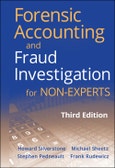A must-have reference for every business professional, Forensic Accounting and Fraud Investigation for Non-Experts, Third Edition is a necessary tool for those interested in understanding how financial fraud occurs and what to do when you find or suspect it within your organization. With comprehensive coverage, it provides insightful advice on where an organization is most susceptible to fraud.
- Updated with new cases and new material on technology tools in forensic accounting
- Covers the core accounting, investigative, and legal aspects of forensic accounting for professionals new to the field
- Covers investigative and legal issues along with accounting schemes
Written by a team of recognized experts in the field of forensic accounting, Forensic Accounting and Fraud Investigation for Non-Experts, Third Edition is essential reading for accountants and investigators requiring the most up-to-date methods in dealing with financial fraud within their organizations.
Table of Contents
Preface xiii
Acknowledgments xv
Part I Forensic Accounting and Fraud Overview 1
Chapter 1 Forensic Accounting 3
What Is Forensic Accounting? 3
Why Has Forensic Accounting Become the Buzz? 4
Introduction to a Profession 5
Applications for Forensic Accounting 6
A Third Dimension: Contexts within Each Area of
Specialization 11
Conclusion 14
Suggested Readings 15
Notes 15
Chapter 2 Fraud in Society 17
What Is Fraud? 17
Types of Fraud 21
Other Types of Financial Fraud 25
Sarbanes–Oxley 27
What the Numbers Tell Us about Fraud 28
Categories of Occupational Fraud 29
Drawing Conclusions 31
Society’s Perception of Fraud 32
Who Commits Fraud? - Profile of the Typical
Fraudster 33
The Social Consequences of Economic Crime 39
Conclusion 39
Suggested Readings 40
Notes 40
Chapter 3 Understanding the Basics of Financial Accounting 43
Where It All Begins 43
The Five Accounting Cycles 46
Journals: Subsidiary and General 54
Conclusion 56
Suggested Readings 56
Note 57
Chapter 4 Forms of Entities 59
Basics of Business Structures 59
Sole Proprietorships 60
Partnerships 60
Corporations 63
Business Enterprises in the Global Environment 66
Conclusion 70
Suggested Readings 70
Notes 72
Chapter 5 Fundamental Principles of Financial Analysis 73
Good Analysis = Due Diligence? 73
Why Perform Financial Analysis? 76
What and Whom Can You Trust? 76
Other Factors to Consider 77
Financial Analysis for the Non-Expert 78
To the Future 85
Conclusion 86
Suggested Readings 87
Notes 87
Chapter 6 The Role of the Accounting Professional 89
The Importance of Accounting Professionals in the Investigation 89
The Audit Process 93
Internal Controls 98
Conclusion 101
Notes 101
Part II Financial Crime Investigation 103
Chapter 7 Business as a Victim 105
Introduction 105
Employee Thefts 106
Fraudulent Billing Schemes 112
Fraud Committed by Outsiders 113
Management Thefts 114
Corporate Thefts 117
Identity Theft 118
Conclusion 120
Suggested Readings 120
Notes 120
CHAPTER 8 Business Villains 123
Introduction 123
Organized Crime and Business 123
Money Laundering 130
Conclusion 137
Suggested Readings 138
Notes 139
Chapter 9 The Investigative Process 143
Introduction 143
Case Initiation 144
Case Evaluation 145
Solvability Factors 147
Goal Setting and Planning 148
Investigation 156
Background 158
Conclusion 166
Suggested Readings 167
Notes 167
Chapter 10 Interviewing Financially Sophisticated
Witnesses 169
Introduction 169
The Interview 170
Interviewing Financially Sophisticated Witnesses 185
Conclusion 188
Suggested Readings 189
Notes 190
Chapter 11 Proving Cases through Documentary Evidence 193
Introduction 193
Document Collection 194
Document Organization 207
The Process of Proof 211
The Logic of Argument 213
Proof through Inference 217
Conclusion 221
Suggested Readings 222
Notes 224
Chapter 12 Analysis Tools for Investigators 227
Introduction 227
Why Use Analysis Tools at All? 227
Associational Analysis 229
Temporal Analysis 246
Conclusion 252
Suggested Readings 252
Notes 253
Chapter 13 Inferential Analysis 255
Introduction 255
How Inferential Analysis Helps 255
What Is an Inference Network? 256
Investigative Inference Analysis 259
The Key List 263
Constructing an Investigative Inference Chart 264
Plotting the Chart 268
Some Tips for Charting Success 272
Applying the Chart to the Investigative Process 273
Conclusion 275
Suggested Readings 275
Notes 277
Chapter 14 Documenting and Presenting the Case 279
Introduction 279
Creating a System 279
The Casebook System 280
Report Writing 287
Testifying as a Financial Expert 290
Conclusion 305
Suggested Readings 305
Notes 306
About the Authors 309
Index 311








